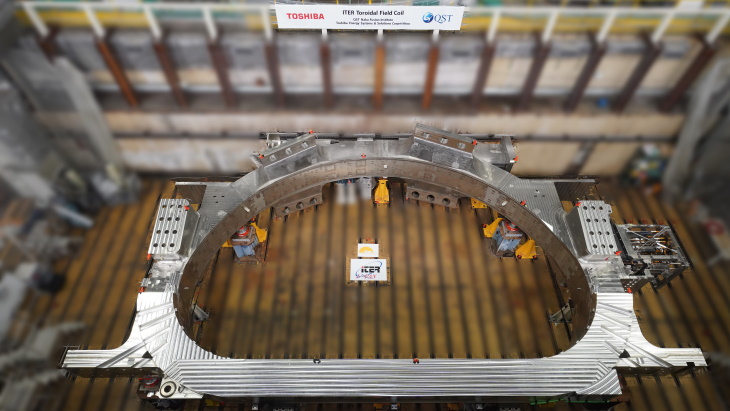Toshiba completes first toroidal coil for ITER: New Nuclear
June 08, 2021
Japan’s Toshiba Energy Systems & Solutions Corporation (Toshiba ESS) announced today that it has completed manufacturing the first of four toroidal field coils for the International Thermonuclear Experimental Reactor (ITER) project. Nine of ITER’s 18 toroidal field coils and a replacement coil are manufactured in Europe, the other nine in Japan. Giant superconducting magnets, they will create the magnetic cage that contains the plasma of the ITER fusion reactor.
The finished toroidal field coil (Image: Toshiba ESS)
The European production of the toroidal field coils is the result of a collaboration between the European domestic agency Fusion for Energy of the Iter organization with ASG Supraconductors, Iberdrola Ingeniería y Construcción, Elytt Energy, CNIM, SIMIC and the ICAS consortium. The production of Europe’s first toroidal field coil was completed in May 2017.
As part of a contract concluded in May 2014 with the Japan Atomic Energy Agency, Toshiba ESS manufactures four toroidal field coils together with six coil housings. In December 2018, the company completed the first coil box. The production of the first coil with a height of 16.5 meters, a width of 9 meters and a total weight of around 300 tons has now been completed.
Shinya Fujitsuka, Director and Senior Vice President of the Power Systems Division at Toshiba ESS, said, “Toshiba ESS will continue to contribute to ITER, which will initiate plasma experiments in 2025 by supplying toroidal coils and packages that require high-precision processing.” Technology to produce. “
ITER is a major international project to build a tokamak fusion facility designed to prove the feasibility of fusion as a large-scale, carbon-free energy source. The goal of ITER is an operation with 500 MW (at least 400 seconds continuously) with 50 MW supplied plasma heating power. It appears that an additional 300 MWe of electricity may be required to operate. No electricity is generated at the ITER.
The European Union bears almost half of the construction costs, while the other six members (China, India, Japan, South Korea, Russia and the USA) bear the rest equally.
Preparatory work for the Cadarache site, southern France, began in January 2007, and the first concrete for the building was poured in December 2013. The first plasma is planned for 2025, the deuterium-tritium fusion experiments begin in 2035.
Researched and written by World Nuclear News



Comments are closed.